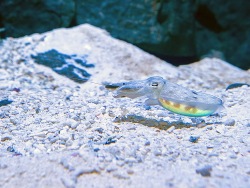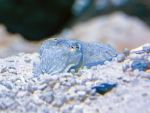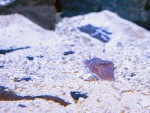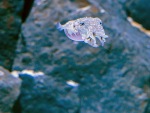Cuttlefish put on camouflage before dinner.

Some visitors think that one of the fish tanks in the “Evolution of Life in the Ocean” exhibit is empty but in reality it serves as a home to a master of camouflage - a golden cuttlefish. The cephalopod uses its camouflage skills almost in every life situation such as hunting, hiding from predators and intraspecific communication. For example, when a rival is nearby, the cuttlefish turns bright-coloured or, sometimes, even black.
“Our cuttlefish preys on live shrimps; before attacking, it waits in ambush completely merging with the surroundings. If the specimen lies on a rock, it imitates both the colour and texture of the rock,” said Viacheslav Ruban, Lead Specialist of the Exotic Species Sector. “Some biologists believe that the cephalopod continuously changes its colour to confuse and hypnotize its prey. During a lightning fast attack, which is mostly successful, the cuttlefish shoots out its tentacle out and grabs a shrimp or a crab. The cephalopod crushes the prey with its beak and slowly consumes it.”
The Aquarium’s cuttlefish is a “gourmet”: it doesn’t eat an entire shrimp since the predator dislikes its head and chitinous carapace. That is why the cuttlefish is sharing the tank with a new companion, a starfish, which consumes everything, including the leftovers the finicky neighbour spits out.
In the wild the cuttlefish uses its camouflage not only to hunt but also to evade large fish and marine mammals. If the disguise doesn’t help to escape from a predator, the cephalopod expels a cloud of ink and turns pale to blend in with the water.


